Alice, Sweet Alice
7.2 /10 1 Votes7.2
80% Rotten Tomatoes Genre Horror, Mystery, Thriller Country United States | 6.5/10 IMDb Budget 340,000 USD Duration Language English | |||||||||||||||||||||||||||||||||
 | ||||||||||||||||||||||||||||||||||
Release date November 13, 1976 (1976-11-13) (US) Cast (Catherine Spages), Mildred Clinton (Mrs. Tredoni), Paula E. Sheppard (Alice Spages (as Paula Sheppard)), Niles McMaster (Dominick 'Dom' Spages), Jane Lowry (Aunt Annie DeLorenze), Rudolph Willrich (Father Tom)Similar movies Interstellar , Inglourious Basterds , Halloween , The Pursuit of Happyness , Independence Day , Vantage Point Tagline If you survive this night... nothing will scare you again. | ||||||||||||||||||||||||||||||||||
Alice sweet alice 1976 trailer
Alice, Sweet Alice (originally known as Communion and also known as Holy Terror) is a 1976 American slasher film co-written and directed by Alfred Sole, and starring Linda Miller, Paula Sheppard, and Brooke Shields in her film debut. The narrative focuses on a troubled adolescent girl who becomes a suspect in the brutal murder of her popular younger sister at her first communion.
Contents
- Alice sweet alice 1976 trailer
- Alice sweet alice 1976 stairway scene
- Plot
- Cast
- Development
- Casting and production
- Release
- Critical reception
- Home media
- Remake
- References
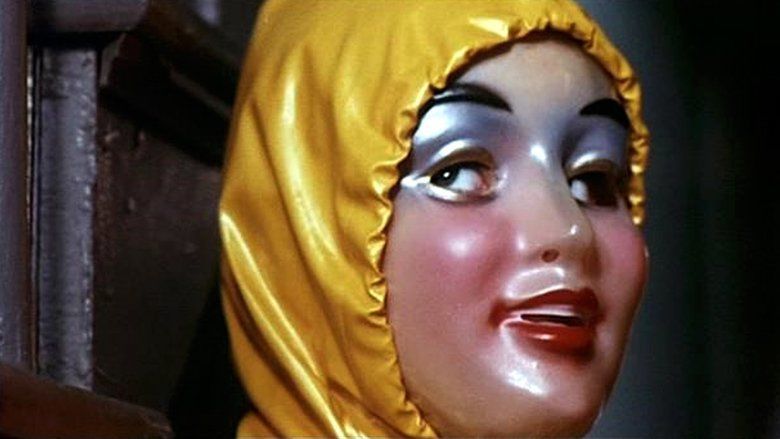
The film premiered at the Chicago International Film Festival under the title Communion in November 1976, and was released theatrically as Alice, Sweet Alice in 1978. It was re-released a third time as Holy Terror in 1981, marketing upon the popularity of Brooke Shields after her notorious performance in Louis Malle's Pretty Baby (1978). The film ranked #89 on Bravo's The 100 Scariest Movie Moments for the scene when Alice scares Karen in the warehouse. In 1977 there was a book adaptation of the film titled Communion by Frank Lauria.
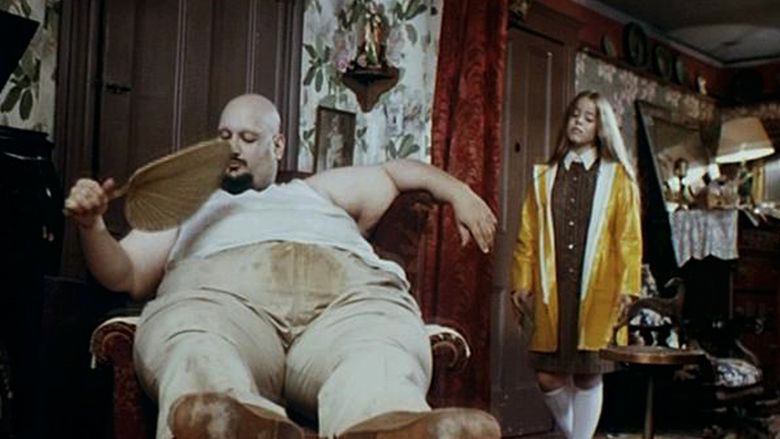
While not prosecuted for obscenity, the film was seized and confiscated in the UK under Section 3 of the Obscene Publications Act 1959 during the video nasty panic.

Alice sweet alice 1976 stairway scene
Plot
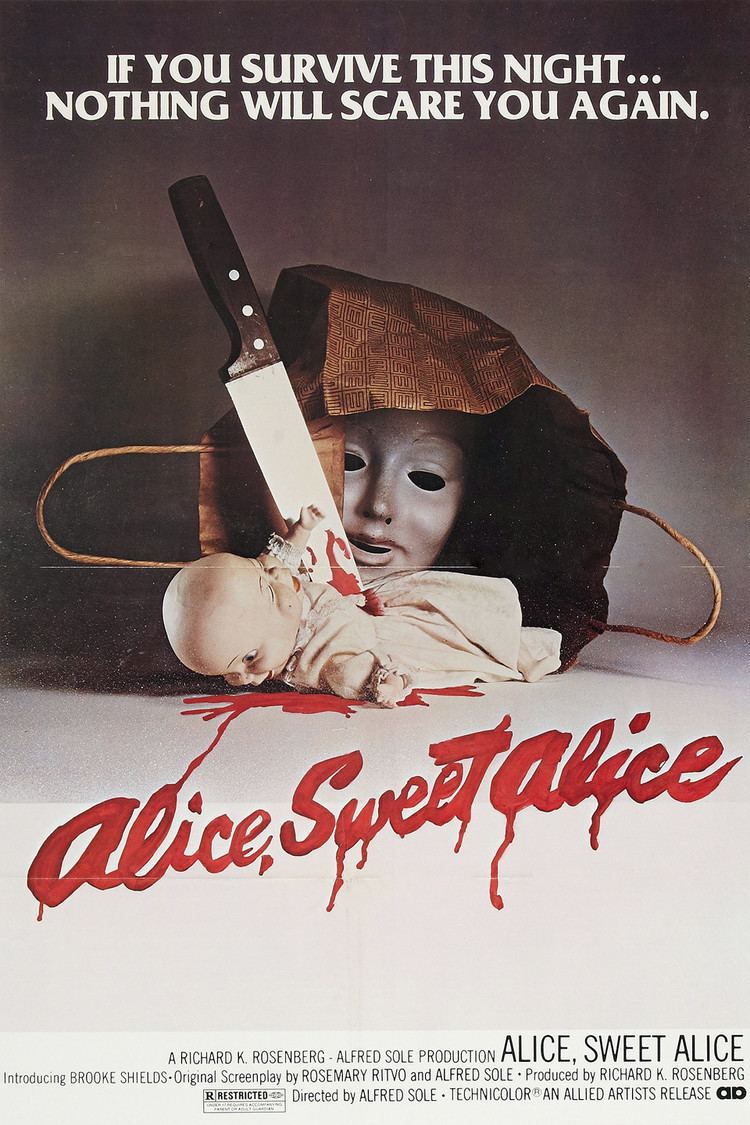
In Paterson, New Jersey in 1961, Catherine Spages (Linda Miller) is visiting Father Tom (Rudolph Willrich) with her two daughters, who both attend St. Michael's Parish Girls' School: 9-year-old Karen (Brooke Shields) and 12-year-old Alice (Paula Sheppard). Karen is preparing for her first communion, and Father Tom gives her his mother's crucifix as a gift. A jealous Alice puts on a translucent mask, frightening Mrs. Tredoni (Mildred Clinton), Father Tom's housekeeper. Later, Alice steals Karen's porcelain doll and lures her into an abandoned building. She jumps out and scares Karen with a double mask and locks her in a room. When she lets her out, she tells her that if anyone finds out she'll never see the doll again.
On the day of her first communion, Karen is attacked and strangled in the church transept by a person wearing a translucent mask and a yellow raincoat. Her body is dragged away and dumped into a bench compartment, which is set on fire with a candle, but not before ripping the crucifix from her neck. Smoke begins to fill the church. Meanwhile, Alice enters the church, carrying Karen's veil. She kneels in place to receive communion when she hears a scream. A nun had entered the back room where the confessionals are located and finds Karen's body. People run in, horrified. Catherine is inconsolable.
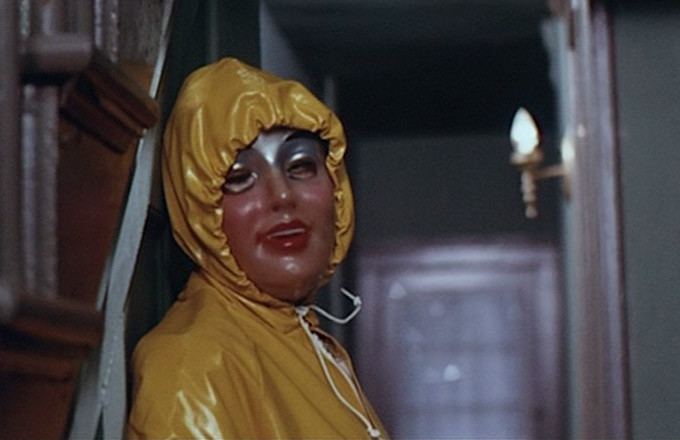
After Karen's funeral, Catherine's estranged husband Dominick (Niles McMaster) arrives to help track down the killer. Annie (Jane Lowry), Catherine's sister, moves in to help Catherine through her grief, but it is clear that Alice and Annie despise each other. Catherine tells Alice to deliver a rent check to their landlord, Mr. Alphonso (Alphonso DeNoble). After he fondles and molests her, Alice grabs one of his many cats and goes down to the basement, where she lights a candle and puts on her mask.
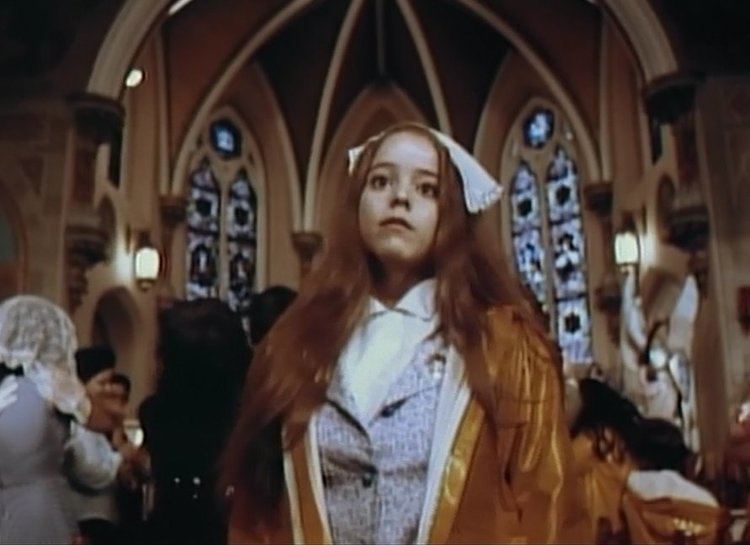
Descending the stairs to go shopping, Annie is attacked by a rain-coated figure in a mask. At the hospital, Annie cries to her husband Jim (Gary Allen) that Alice tried to kill her. Catherine says that Annie is only accusing Alice of Karen's murder to divert attention from her own daughter Angela (Kathy Rich), who was absent at the time of the murder. Alice is sent to a mental institution for evaluation.

At the hospital with Father Tom, Dominick receives a hysterical phone call from someone claiming to be Angela, saying that she has Karen's crucifix and is in hiding. They agree to meet at an abandoned building. Outside, Dominick spots and then follows the rain-coated figure. He goes inside and up the stairs where the killer stabs him in the shoulder, and he is knocked out by a brick and tied up. Dominick awakens and sees that the killer is in fact Mrs. Tredoni. She reveals that she stabbed Annie by mistake, thinking it was Catherine, whom she considers a whore. She calls Dominick and Catherine sinners because they had premarital sex. After Dominick bites the crucifix off her neck, Mrs. Tredoni beats him with a brick and pushes him out of the window.
After a pathologist (Lillian Roth) analyzes Dominick's corpse, the crucifix is found, and Alice is released. After hearing of Dominick's death, Catherine tries to visit Father Tom. He is not at home, but Mrs. Tredoni invites Catherine in. Mrs. Tredoni tells Catherine that her own daughter died on the day of her first communion and that she then realized children are punished for the sins of their parents and that Mrs. Tredoni since devoted her life to the church and specifically, Father Tom. Mrs. Tredoni seemingly threatens Catherine with a knife when Father Tom and the pair leave to pick Alice up from the mental institution, as the police have eliminated her as a suspect since she was incarcerated when Dominick was killed.

When Catherine and Alice go to church, Mrs. Tredoni sneaks into the apartment building. As Mrs. Tredoni bangs on Catherine's apartment door, not realizing the pair are not in, Mr. Alphonso wakes up screaming, as Alice had put a jar of cockroaches on his belly before leaving. He spots Mrs. Tredoni and mistakes her for Alice. She stabs him twice and runs downstairs. However, Detective Spina witnesses her running out of the back entrance without the mask on.
Mrs. Tredoni goes to church, where the police are stationed outside. Father Tom denies her communion. Mrs. Tredoni points at Catherine, screams that he gave communion to a whore, and violently stabs Father Tom as the police rush in. Father Tom dies in Mrs. Tredoni's arms.
Ultimately, Alice walks out of the church with Mrs. Tredoni's shopping bag, placing the bloodstained butcher knife into it.
Cast
† credited as Paula Sheppard
‡ credited as Miss Lillian Roth
Development
Director Alfred Sole began writing the film in 1974, collaborating with co-writer Rosemary Ritvo on the script. Sole stated that he was inspired to make the film after seeing Nicolas Roeg's 1973 thriller, Don't Look Now, based on the novel by Daphne du Maurier. As a result, Alice, Sweet Alice makes several visual references to Don't Look Now, namely the usage of the raincoat which is featured on the villains in both films. Sole was also influenced by the works of Alfred Hitchcock, as well as the 1955 French film Les Diaboliques, while assembling compositions in the film. Although many critics have drawn comparisons to Italian giallo films and the works of Dario Argento in particular, Sole claimed to have not seen Argento's work at the time. No less, the film's incorporation of subtle dark humor and its unsympathetic portrayal of religion— both motifs of giallo thrillers— led to the film's reputation as the most "gialloesque" American film in history.
Film scholars have noted the film's hysterical portrayal of Catholicism and religious institutions to be in direct conversation with the motives of its villain, Mrs. Tredoni, whose ultimate goal is to "punish" the sinning members of her parish; this has resulted in some claiming the film to be overtly "anti-Catholic". Writer/director Sole's own proclaiming of himself as an "ex-Catholic" supports this interpretation of the film's religious themes and undertones. Prior to writing and directing Alice, Sweet Alice, Sole had directed his debut feature, an adult film titled Deep Sleep, in 1972. The release of the film resulted in obscenity charges being brought against him in the state of New Jersey, as well as formal excommunication from the Roman Catholic Diocese of Paterson, New Jersey; this event has been credited as influential to the apparent anti-religious bent of Alice, Sweet Alice.
The murder scenes in the film in particular have been described by genre scholars as "stark and shocking," and noted for their use of "powerful imagery" correlating with the film's religious overtones. Catholic iconography is featured prominently throughout the film, including votive candles, crucifixes, and rosaries, as well as artistic depictions of the Virgin Mary in sculptures and paintings.
Casting and production
Brooke Shields was the first to be cast in the film after auditioning in New York City in 1975; director Sole had seen her modeling in advertisements prior, and contacted her mother about the film, expressing his interest in her playing the role of young Karen. It was also actress Paula Sheppard's debut. Sheppard, a college student, was 19 at the time she played 12-year-old Alice, and was discovered by Sole working as a dancer in a local university's stage productions. Alphonso De Noble, a New Jersey native, was cast as the tenacious landlord after director Sole had seen him impersonating a priest in local cemeteries. Sole had originally sought veteran stage actress Geraldine Page for the role of Mrs. Tredoni; Page, however, could not play the character due to obligations in a Broadway production, but recommended fellow stage actress Mildred Clinton, who played the role.
The film was shot on location in Paterson, New Jersey in 1975, though the film is set in the early 1960s; many of the crew, including cameramen and sound designers were from New York City. Sole, a native of Paterson, was working as an architect at the time and used several historic buildings which he had worked on restoring as filming locations, lending the film a modern Gothic aesthetic. The production was periodically postponed during filming, with Sole stating that sometimes two to four week breaks would be taken between filming sessions due to budget issues.
For the film's special effects, which included multiple murder sequences by bludgeoning and stabbing, Sole hired friend William Lustig, who would later direct the cult horror film Maniac (1980). Lustig also worked as an assistant cameraman on the film. Dick Vorisek, who had previously worked on Dog Day Afternoon (1975) and Carrie (1976), was hired onto the film as chief sound engineer after Sole was put in contact with him through Technicolor.
Release
The film premiered under the title Communion at the Chicago International Film Festival in early November 1976, and debuted in Paterson, New Jersey, on November 13, 1976. According to director Alfred Sole, Columbia Pictures had signed on to distribute the film in the United States, as well as securing a book tie-in by author Frank Lauria, which was written in conjunction through Bantam Books. However, following legal "friction" concerning rights to the movie, Columbia Pictures ultimately dropped the film from its roster.
Allied Artists then purchased the film for distribution, and forced the filmmakers to change the title from Communion to Alice, Sweet Alice, out of fear that the public would perceive it to be a Christian film. Allied Artists' revised title, Alice, Sweet Alice, originated from a quote in Volume 16 of the Publications of the Catholic Truth Society, published in 1898, which reads: "Then there is Alice—sweet Alice—your eldest born, who leans over the back of your chair and sweeps your face with her brown curls." Director Sole reportedly fought Allied Artists on the changing of the title to no avail; the film was ultimately released as Alice, Sweet Alice in 1978. The novelization, however, was still published under the original Communion title.
Following the rising fame of Brooke Shields after her performance in Pretty Baby (1978), the film was released for a third time in 1981 under the title Holy Terror.
Critical reception
Alice, Sweet Alice received generally favorable reviews from critics upon release. Roger Ebert gave the film a positive review, stating: "Director Alfred Sole has a brilliant touch for the macabre and there are some splendidly chilling scenes," while US Magazine called the film a "superior modern Gothic thriller." Leonard Maltin awarded the film a mixed 2 out of 4 stars, calling it "[an] OK murder mystery." Patrick Legare of AllMovie called the film an "eerie, effective chiller," praising the film's cinematography, and awarding it four-and-a-half out of five stars. Slant Magazine noted in their review of the film: "Possibly the closet American relation to an Italian giallo, the film is head-trippingly hilarious (Jane Lowry, as Aunt Annie, may be the nuttiest screamer in the history of cinema) and features some of the more disquieting set pieces you'll ever see in a horror film."
Upon the film's 1981 re-release under the title Holy Terror, Vincent Canby of The New York Times gave the film a positive review, writing: "Mr. Sole, whose first feature this is, knows how to direct actors, how to manipulate suspense and when to shift gears: the identity of the killer is revealed at just that point when the audience is about to make the identification, after which the film becomes less of a horror film than an exercise in suspense. He also has a good feeling for the lower middle-class locale and the realities of the lives of the people who live in it." A review published by TV Guide gave the film four out of five stars, calling it "an excellent low-budget horror film from director Sole, whose impressive grasp of filmmaking technique and eye for the grotesque keeps the viewer on edge throughout the movie." Time Out, London also gave the film a positive review, noting: "The plot investigates the murder; the film examines the family's self-destruction; and the film-makers construct a running commentary on the themes of Alfred Hitchcock: against a carefully evoked background of Catholicism emerge twin themes of repression and guilt."
Home media
During the changes in distributors and due to a myriad of legal problems, the film was not properly registered with the United States Copyright Office in 1975 during its production. As a result, the film became widely bootlegged in the following years. It was released officially by Anchor Bay Entertainment on VHS in 1997, and on laserdisc by the Roan Group, in a remastered and uncut print supervised by director Alfred Sole. It was later released on DVD in 1999 by Anchor Bay Entertainment; after this edition of the film became out of print, it was re-released on DVD by Hen's Tooth Video in 2007.
Remake
In 2007 director Dante Tomaselli announced his intent to direct a remake, confirmed that he had completed a script with Michael Gingold. Tomaselli will also score the film using original pieces and re-mastered and remixed musical compositions from the original film. In 2013 actress Kathryn Morris was confirmed to be performing in the film and will assume the role of Catherine Spages. The film will be set in the 1970s as opposed to setting it in modern times or in its original 1960s setting, as Tomaselli wanted to be "somewhat more recent while not at all losing its retro style". In May 2016, Tomaselli revealed that the film had suffered delays due to lack of funds, but also stated that he had been in recent contact with "solid prospects from European production companies and producers."
References
Alice, Sweet Alice WikipediaAlice, Sweet Alice IMDbAlice, Sweet Alice Rotten TomatoesAlice, Sweet Alice themoviedb.org
